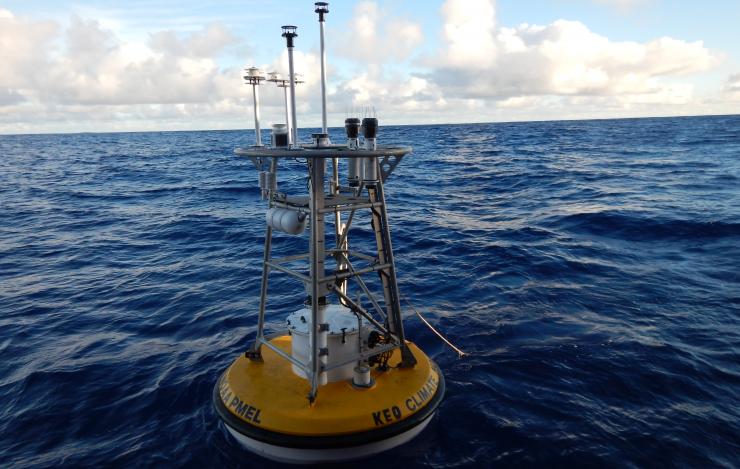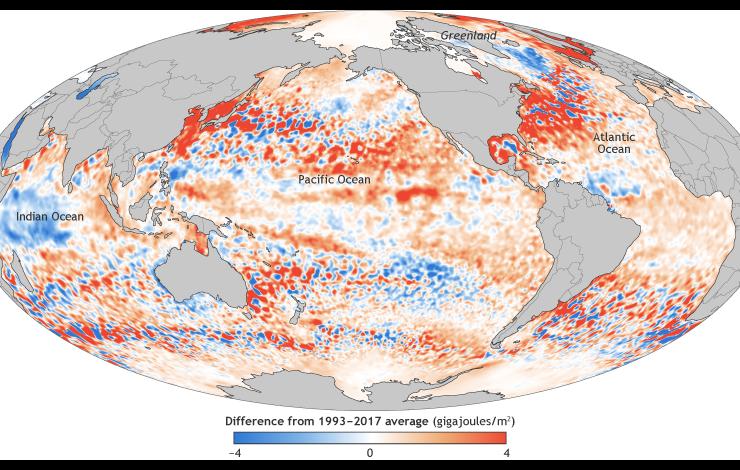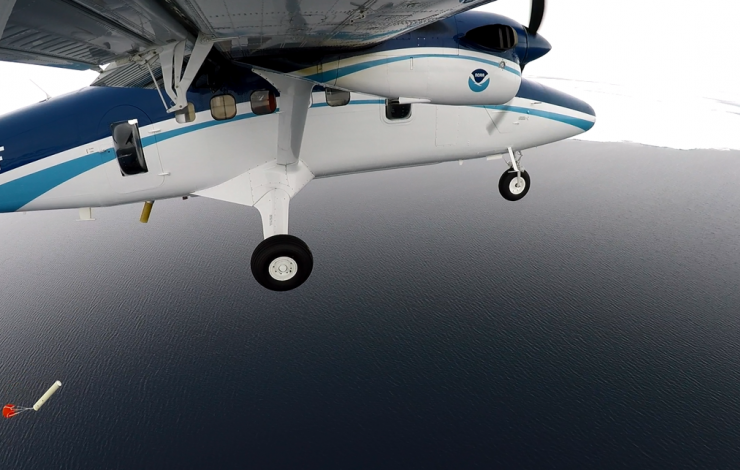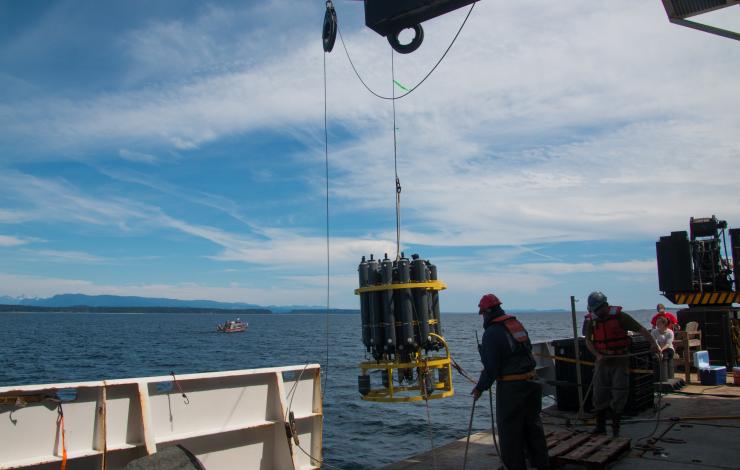What's New Archive
On October 17, 2018, a joint NOAA/PMEL and Oregon State University Marine Mammal Institute (OSU-MMI) team, with the assistance of a U.S. Coast Guard helicopter on patrol providing real time radio reports of cetacean sightings, traveled 27 miles off the Oregon coast (due west of Newport, Oregon) to acquire acoustic recordings and biopsy two North Pacific blue whales. Through MMI contacts, the Coast Guard helicopter out of North Bend spotted blue whales off shore during routine patrol, and alerted the team to their approximate location.
A PMEL drifting hydrophone was used to record the blue whale calls, while OSU-MMI personnel successfully collected a biopsy sample of one of the two blue whales, and documented the encounter with photographs. Genetic results show the biopsied animal was a male, acoustic analysis of call signal strength shows two animals observed during biopsying were likely source of recorded vocalizations. The researchers are currently doing further genetic analysis and photo identification work to confirm blue whale population and gender of animals recorded. These data will be used to correlate the genetic identity and acoustic call type of a North Pacific blue whale.
The goal is to quantify and relate call signal characteristics and genetic identity. Typically, only remote recordings of blue whale calls are used to assess population size and distribution of this endangered species.
All research was conducted under NMFS permit 20465 with the support of the Marine Mammal Institute whale telemetry group.
The University of Washington and NOAA Center for Tsunami Research at PMEL recently conducted a study for Department of Defense (DOD) overseas sites to ensure compliance of tsunami inundation modeling with recently established standards and guidelines by the American Society for Civil Engineers (ASCE). This update helps assess tsunami hazard at DOD facilities and identifies compliant design parameters for construction in tsunami hazard zones.
An extensive modeling effort for 23 Navy sites in the Pacific established detailed tsunami hazard zone maps in coastal areas and provided modeling data for building design guidance for tsunami-resistant buildings within the hazard zones.
No design criteria had existed in U.S. to address tsunami loads and effects on buildings before 2016. This work followed the new and first guidance from the American Society for Civil Engineers (ASCE 7-16)established in 2016, for constructions in tsunami hazard zones. The guidance requires establishing the hazard maps for the 2,500-year tsunami event, consistent with the National Seismic Hazard Maps, using probabilistic methods. This approach required intensive modeling efforts including hundreds of simulations with very high-resolution models for sources from areas prone to earthquakes that may trigger tsunamis, including the Ryukyu, Japan-Kuril, Mariana and Alaska-Aleutian trenches.
This project is funded by Navy Facilities and the National Institute of Building Science.
A hybrid quadrotor (HQ) unmanned aircraft systems (UAS) platform with the ability of vertical take-off and landing (VTOL) and conversion to fixed wing (FW) flight allows for operations from ships, where launch and recover space is constrained while maintaining the range and endurance of a FW aircraft. The HQ technology eliminates the need for rail launchers and aerial capture technologies such as large nets and wires. With a capability of carrying a 15 lb payload and an endurance of 5 to 15 hours such an HQ UAS would greatly enhance many areas of NOAA research including climate and air quality studies, fishery and mammal surveys, oil spill detection, weather observations, and post severe weather damage assessments. With funding from the NOAA UAS Program Office, the Atmospheric Chemistry Group at NOAA PMEL has been working toward building this capability within NOAA with the goal of making vertical measurements of aerosol properties from a NOAA ship.
In June of 2016, PMEL worked with Latitude Engineering (now L3 Latitude) proving the concept of VTOL-FW launch and recovery of a 20-lb test HQ UAS from the NOAA RV Oscar Elton Sette. With lessons learned from those tests, L3 Latitude is currently in the second phase of a NOAA Small Business Innovation Research (SBIR) to develop an HQ-55 UAS able to fly autonomously from a NOAA ship. The HQ-55 is being designed with a 15-lb payload capability, 5 to 15-hour flight endurance depending on payload weight, and an altitude ceiling of 14,000 ft. At a total weight of under 55-lbs (including the payload) the HQ-55 will be compliant with FAA Part 107 which allows for the operation of UAS in National Airspace.
In a parallel effort, PMEL is developing an aerosol payload for integration into the HQ-55 with instruments able to measure total particle number concentration, particle number size distribution, aerosol light absorption, solar irradiance and sky radiance, aerosol composition, and meteorological parameters. The payload is modular in design to allow for quick swapping in and out of the UAS so that multiple payloads, each with different measuring capabilities, can be used during a given observation period. A previous version of the payload was flown in the Arctic (Svalbard, Norway) in 2011 and 2015 to investigate climate impacts of soot pollution. Through that work, the aerosol payload transitioned to Technical Readiness Level 8, system demonstration in an operational environment.
First shipboard tests of the HQ-55 with the integrated aerosol payload are planned for Spring 2019 from a NOAA ship. As part of these flights, NOAA pilots will continue training to fly the HQ-55. Through a collaboration between NOAA PMEL, the UAS Program Office, the Office of Marine and Aviation Operations, and the SBIR Program Office, the ultimate goal is to provide a VTOL-FW UAS capability within NOAA for use by all line offices through the Aircraft Operations Center.
Learn more about NOAA's Unmanned Aircraft Systems Program here: https://uas.noaa.gov/
Learn more about PMEL's Atmospheric Chemistry Group: https://saga.pmel.noaa.gov/
This weekend, the EcoFOCI program completed its eleventh and final research cruise of its field season on the F/V Aquila to maintain and enhance an innovative array of biophysical moorings in conjunction with annual ship-based hydrographic data in the Bering Sea.
The team recovered 14 and deployed 10 moorings, including swapping the M2-site surface mooring for a sub-surface mooring to prevent damage from the ice to ensure 25 years of nearly continuous data. Scientists from PMEL, NOAA Fisheries Alaska Science Center and University of New Hampshire also collected some measurements from a CTD (conductivity-temperature-depth), nutrients, oxygen, plankton and larval fish along the Distributed Biological Observatory (DBO) Line 1, which has only been sampled once in 2017. These DBO lines are designated “hot spots” centered on locations of high productivity, biodiversity and rates of biological change in the Bering, Chukchi, and Beaufort seas.
Results from these observations and experiments will help describe important ecosystem linkages among climate, plankton, fishes, birds and mammals. Continuous monitoring from this region provides critical data to support sustainable management of living resources in the Bering Sea.
The EcoFOCI program is a collaborative research effort by scientists at the Pacific Marine Environmental Lab (PMEL) and Alaska Fisheries Science Center (AFSC) focusing on the unique and economically important high-latitude ecosystems of Alaska.
This week, four saildrones departed from Hawaii on the second mission to the equator in an effort to improve the Tropical Pacific Observing System (TPOS). NOAA forecasts a 50-55% chance of a weak El Niño developing during September - November 2018, increasing to 65-70% chance during winter 2018-19. The second saildrone mission will thus capture ocean and atmospheric data during this developing El Niño, including changes in ocean temperature, winds, currents and ocean carbon dioxide concentrations.
During the first mission in late 2017-early 2018, La Niña conditions were present. Strong currents and low winds on the equator made navigation challenging. This year, two of the four saildrones have been outfitted with larger, more efficient sails, making them faster and more capable in low wind-strong current environments.
This mission is part of a series of saildrone missions to the tropical Pacific, focusing on how this new technology could best be used within the TPOS to improve longterm weather forecasts.
PMEL began a partnership with Saildrone, Inc. in 2014 to develop the unmanned surface vehicles for collecting high quality oceanic and atmospheric observations. PMEL's Ocean Climate Stations group has been working together with PMEL engineers and Saildrone, Inc. since 2016 to install sensors on the drones with equivalent or better quality than those currently used on TAO moorings for air-sea flux measurements.
Follow the TPOS Saildrones’ progress at: https://www.pmel.noaa.gov/ocs/ocs-saildrone-mission-blog-tpos-mission-2
This mission is supported by NOAA Research's Global Ocean Monitoring and Observing Program, NOAA's Office of Marine and Aviation Operations and Saildrone, Inc.
Seasonally ice-covered marginal seas are among the most difficult regions in the Arctic to study. The scarcity of observing systems in these areas also hinders forecast services in the region and is a major contributor to large uncertainties in modeling and related climate projections. The Arctic Heat Open Science Experiment strives to fill this observation gap with an array of innovative autonomous floats and other near real-time weather and ocean-sensing systems that allow for continuous monitoring of changing conditions in the Chukchi Sea. Since 2016, over 1,000 Arctic Ocean profiles have been collected by the Arctic Heat project and transmitted in real-time via the Global Telecommunications System (GTS). Data collected during the 2017 field season showed particular warmth in the lower ocean which was a leading factor for the record late freeze up (1 month later than usual) in the region and likely would not have been detected without this field campaign. This event caused a ripple effect including impacts on whale migration patterns, physical ocean circulation patterns and subsistence hunt practices that depend on ice.
This week, researchers aboard the NOAA Twin Otter are launching various atmospheric and oceanographic probes and floats as part of the third and final flight campaign of 2018. They will launch an Air-Launched Autonomous Micro-Observer (ALAMO) profiling float and 20 Airborne eXpendable BathyThermographs (AXBT) and carry out a set of low level surveys around the R/V Sikuliaq using LIDAR, longwave radiometry, and thermal imaging. They will also be on the lookout for higher wind/wave situations to collection additional data for NASA's Ice, Cloud and land Elevation Satellite (ICESat) 2 which will be launched on September 14.
Arctic Heat is an open science experiment, publishing data generated by the project to further NOAA's Science Missions with real-time data to facilitate timely observations for use in weather and sea-ice forecasts, to make data readily accessible for model and reanalysis assimilation, and to support ongoing research activities across disciplines.
This mission is in coordination with the Office of Naval Research (ONR)'s Stratified Ocean Dynamics of the Arctic (SODA) in response to the White House Office of Science and Technology Policy's "Interagency Research Effort To Improve Weather, Ice, and Water Forecasting in the Arctic Ocean" led by ONR, NOAA, National Science Foundation, Bureau of Ocean Energy Management (BOEM) and NASA. Arctic Heat is a joint effort of NOAA Pacific Marine Environmental Laboratory (PMEL) Arctic Research, the Innovative Technology for Arctic Exploration (ITAE) program, the ALAMO development group at the Woods Hole Oceanographic Institution (WHOI), and the Joint Institute for the Study of the Atmosphere and Ocean (JISAO) at the University of Washington.

The OCS Kuroshio Extension Observatory (KEO) surface mooring off the coast of Japan. It is an Ocean Climate Station (OCS) mooring that is part of the global network of OceanSITES time series reference sites. Photo Credit: Patrick Berk
In a recently published paper in the journal Progress in Earth and Planetary Science, PMEL’s Dr. Meghan Cronin collaborated with Japanese colleagues, including lead author Dr. Makio Honda, to conduct a comparative study of the ecosystem and its biogeochemistry using time series at the Kuroshio Extension Observatory (KEO) station off the coast of Japan.
Combining data from the Japan Agency for Marine-Earth Science and Technology (JAMSTEC) sediment trap mooring with NOAA surface mooring data, this study shows changes in organic materials at the sediment trap are traced not only to springtime blooms, but also to cyclonic eddies that passed the site in the late summer-early fall. These eddies caused nutrients to rise into the euphotic zone, a layer closer to the ocean surface that receives enough light for photosynthesis to occur, and generate subsurface blooms that weren't detected by satellite.
NOAA has maintained a surface mooring at KEO since 2004, and JAMSTEC has maintained a subsurface sediment trap at KEO since 2014. The KEO surface mooring carries a suite of instrumentation to monitor air-sea exchanges of heat, moisture, momentum (wind stress), and carbon dioxide; surface ocean acidification; and upper ocean temperature, salinity and currents. The combined data sets from both moorings enable computation of the physical and biological pumps of the carbon cycle in this key region of the North Pacific. As such, the site has become a focal point for international climate research.
The working relationship between PMEL and JAMSTEC at the KEO site began in 2007, and continues to be a valuable partnership.
NOAA and partner scientists speaking Friday, August 17, at the Goldschmidt annual international conference on geochemistry reported their research is finding that coastal waters and river estuaries are more vulnerable to ocean acidification than offshore waters. These waters are more severely affected by ocean acidification because they receive fresh water runoff that contributes to higher levels of dissolved carbon dioxide.
This acidification, detected in research cruises off the United States West Coast and Gulf of Mexico, can cause some marine fish species to suffer cognitive problems and disorientation, the scientists said, with these fish losing their way or even swimming towards predators. Researchers also find that dissolved carbon dioxide levels are disproportionately affecting the wellbeing of fish in colder northern waters, such as off the state of Washington, than in warmer coastal waters such as the Gulf of Mexico.
“We checked coastal waters in the Gulf of Mexico, and all along the U.S. West coast,” said Richard Feely, a NOAA senior scientist. “We found that cold water changes the water’s chemistry, so that it can’t buffer itself as effectively against changes in acidity. This can cause large fluctuations in the CO2 levels according to the season, with colder areas being more vulnerable to large swings in the partial pressure of carbon dioxide in the ocean. It is these increases in partial pressure of carbon dioxide which threaten the well-being of marine life.”
NOAA and partner scientists studied water samples collected from a series of research cruises that took place in 2007, 2011, 2012, 2013 and 2016, and found that there were significant differences in the levels of CO2 dissolved in the ocean water. The research was funded through the NOAA Ocean Acidification Program .
To read the full news release go online to: https://goldschmidt.info/2018/pressReleasesView
Editor's note: The following story is adapted from a news release issued Friday, August 17, 2018, at the Goldschmidt Conference.
International Annual State of the Climate Report Finds 2017 was One of Three Warmest Years on Record

This map shows the ocean heat content in the upper ocean (from the sea surface to a depth of 700 meters, or 2,300 feet) for 2017 relative to the 1993–2017 baseline. It's based on a combination of Argo float observations and satellite data. Places with higher-than-average heat storage are orange, while places with lower-than-average heat storage are blue
The 28th annual State of the Climate report was recently released highlighting that 2017 was the third-warmest year on record for the globe, behind 2016 and 2015. The new report confirmed that 2016 surpassed 2015 as the warmest year in 137 years of recordkeeping. Several climate indicators also set new records, including greenhouse gas concentrations, sea level rise, heat in the upper ocean, and Arctic sea ice extent.
The 2017 average global CO2 concentration was the highest measured in the modern 38-year global climate record and records created from ice-core samples dating back as far as 800,000 years. Sea level rise also hit a new high, about 3.0 inches higher than the 1993 average and rising globally, at an average rate of 1.2 inches per decade. Heat in the upper ocean hit a record high, reflecting the continued accumulation of thermal energy in the uppermost 2,300 feet of the global oceans. Arctic sea ice maximum extent (coverage) was the lowest in the 38-year record. Extreme precipitation was also recurring theme this past year.
Surface fluctuates,
ocean warms more steadily,
seas continue rise.
The State of the Climate in 2017 was recently published in a special edition of the Bulletin of the American Meteorological Society. This report is led by NOAA's National Centers for Environmental Information and is based on contributions from more than 500 scientists representing over 65 countries around the world. It is the most comprehensive annual summary of Earth’s climate and provides a detailed update on global climate indicators, notable extreme weather events and other environmental data collected from locations on land, water, ice, and in space.
Principal investigators from PMEL’s Carbon, Arctic and Large Scale Ocean Physics programs contributed to sections on the global ocean carbon cycle, ocean heat content and arctic air temperature. Dr. Greg Johnson served as the editor for the Global Oceans chapter for the third consecutive year.
Access the full BAMS State of the Climate in 2017 report here.
The recent Research Moored Array for African-Asian-Australian Monsoon Analysis and Prediction (RAMA) cruise aboard the NOAA Ship Ronald H. Brown, which departed Goa, India on June 14, established three new RAMA sites in the Arabian Sea along 65E and 67E. The cruise also maintained five existing RAMA moorings along 67E and finished on July 19 in Darwin, Australia.
RAMA was designed to study the Indian Ocean’s role in the monsoons. One third of the world population depends on monsoon driven rainfall for agricultural production, so improving our understanding and ability to predict the monsoons has been a longstanding objective of the international scientific community.
RAMA, the newest tropical moored buoy array (the other two being in the Pacific and Atlantic Oceans), was initiated in the traditionally data sparse Indian Ocean in 2004 via multi-national partnerships led by NOAA/PMEL. The new moorings bring RAMA to near completion and will help NOAA and other weather forecast centers around the world continue to improve monsoon predictions.









